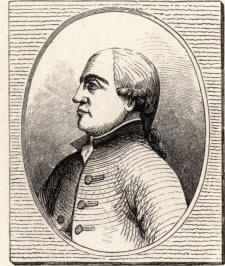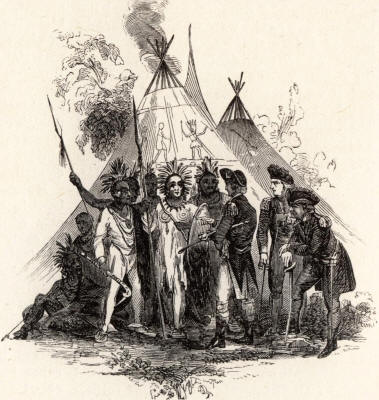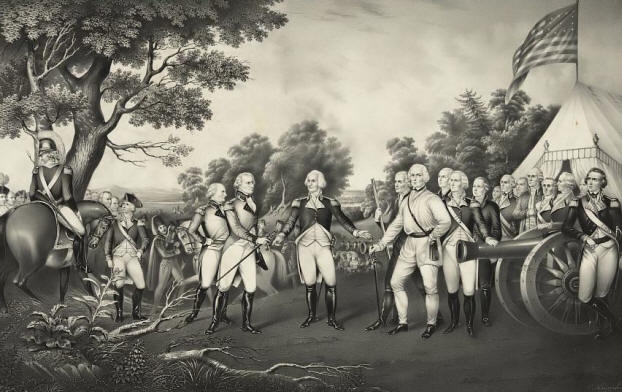General John Burgoyne
|
|
This Site:
|
Already another invading force of British regulars, Canadians, Tories, and Indians, under Colonel St. Leger, which was sent by Burgoyne, by way of Oswego, to march down the Mohawk Valley and meet the latter at Albany, had been defeated in a battle at Oriskany (August 6). Schuyler was superseded by Gates in command of the northern army. Gates formed a fortified camp on Bemis's Heights to oppose the onward march of Burgoyne down the Hudson Valley. There he was attacked (September 19) by the British; and, after a severe battle, the latter retired to their camp on the heights of Saratoga (afterwards Schuylerville) to await the approach of Sir Henry Clinton from New York. The latter captured forts on the Hudson Highlands, and sent marauding expeditions up the river that burned Kingston. Again Burgoyne advanced to attack Gates. He was defeated (October 7), and again retired to his camp. Finding it impossible to retreat, go forward, or remain quiet, he surrendered his whole army, October 17, 1777. See BEMIS'S HEIGHTS.
Surrender of General BurgoyneThe vanquished troops made prisoners to the Americans by a convention for the surrender of them, made by Gates and Burgoyne, were marched through New England to Cambridge, near Boston, to be embarked for Europe. The Congress had ratified the agreement of Gates that they should depart, on giving their parole not to serve again in arms against the Americans. Circumstances soon occurred that convinced George Washington that Burgoyne and his troops intended to violate the agreement at the first opportunity, and it was resolved by the Congress not to allow them to leave the country until the British government should ratify the terms of the capitulation. Here was a dilemma. That government would not recognize the authority of the Congress as a lawful body; so the troops were allowed to remain in idleness in America four or five years. Burgoyne, alone, was allowed to go home on his parole. The British ministry charged the Congress with absolute perfidy; the latter retorted, and justified their acts by charging the ministry with meditated perfidy. Owing to the difficulty of finding an adequate supply of food for the captive troops in New England, the Congress finally determined to send them to Virginia. Commissioners sent over, in the spring of 1778, to tender a scheme of reconciliation, offered a ratification of the convention, signed by themselves; but Congress would recognize no authority inferior to the British ministry for such an act. Finally, in pursuance of a resolution of Congress (October 15, 1778), the whole body of the captives (4,000 in number), English and German, after the officers had signed a, parole of honor respecting their conduct on the way, took up their line of march, early in November, for Charlottesville, Virginia, under the command of Major-General Phillips. Col. Theodoric Bland was appointed by Washington to superintend the march. It was a dreary winter's journey of 700 miles through New England, New York, New Jersey, Pennsylvania, Maryland, and Virginia. The routes of the two nationalities were sometimes distant from each other, and sometimes the same, until they reached Valley Forge, when they went in the same line until they had crossed the Potomac River. They remained in Virginia until October, 1780, when the danger that the captives might rise upon and overpower |
|
|
||
|
|
Site Copyright 2003-2018 Son of the South. For Questions or comments about this collection, contact: paul@sonofthesouth.net |
|
|
Are you Scared and Confused? Read My Snake Story, a story of hope and encouragement, to help you face your fears. |
||
 Burgoyne,
SIR JOHN, military officer; born in England, February 24,
1723; was liberally educated, and entered the army at an early age.
While a subaltern he clandestinely married a daughter of the Earl of
Derby, who subsequently aided him in acquiring military promotion
and settled $1,500 a year upon him. He served with distinction in
Portugal in 1762. The year before, he was elected to Parliament, and
gained his seat as representative of another borough, in 1768, at an
expense of about $50,000. In the famous Letters of Junius he was
severely handled. Being appointed to command in America, he arrived
at Boston May 25, 1775; and to Lord Stanley he wrote a letter,
giving a graphic account of the
Burgoyne,
SIR JOHN, military officer; born in England, February 24,
1723; was liberally educated, and entered the army at an early age.
While a subaltern he clandestinely married a daughter of the Earl of
Derby, who subsequently aided him in acquiring military promotion
and settled $1,500 a year upon him. He served with distinction in
Portugal in 1762. The year before, he was elected to Parliament, and
gained his seat as representative of another borough, in 1768, at an
expense of about $50,000. In the famous Letters of Junius he was
severely handled. Being appointed to command in America, he arrived
at Boston May 25, 1775; and to Lord Stanley he wrote a letter,
giving a graphic account of the
 He
left St. Johns on the Sorel (June, 1777) with a brilliant and
well-appointed army of 8,000 men, and ascended Lake Champlain in
boats. At the falls of the Bouquet River, near the western shore of
the lake, he met about 400 Indians in council, and after a feast
(June 21, 1777) he made a stirring speech to them. On July 1 he
appeared before
He
left St. Johns on the Sorel (June, 1777) with a brilliant and
well-appointed army of 8,000 men, and ascended Lake Champlain in
boats. At the falls of the Bouquet River, near the western shore of
the lake, he met about 400 Indians in council, and after a feast
(June 21, 1777) he made a stirring speech to them. On July 1 he
appeared before 